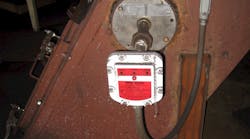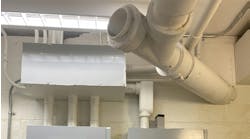In the last issue, we discussed requirements for installing equipment in Class I locations. This month, we’re continuing with the NEC’s sequence of hazardous location articles to discuss Class II locations. In a nutshell, if the ignitable material is normally present (in sufficient quantities to present a hazard), then it’s a Div. 1 location. Less stringent requirements apply for a Div. 2 location, because ignitables are present only in abnormal circumstances.
Like Art. 501, Art. 502 presents many requirements with a Division-based pattern. Where a subsection has an A and a B, the A is for Div. 1, and the B is for Div. 2. It’s much easier to keep out dust than gases, so Art. 502 is much shorter than Art. 501. Often, the only requirement is that the equipment be identified for the location.
Article 502 gives you the option of using the Zone system (Art. 506) instead of the Division system [502.6]. However, we’ll discuss Art. 506 in a future issue of the magazine.
Wiring methods
In Class II locations, any wiring method allowed for Div. 1 is allowed for Div. 2 [502.10(B)(1)(1)]. For Div. 2, you can use these wiring methods in addition to any used for Div. 1:
• Rigid metal conduit (RMC) or intermediate metal conduit (IMC) whether threaded or not (for Div. 1, these conduits must be threaded).
• Electrical metallic tubing.
• Dusttight wireways.
• Type MC cable with listed termination fittings.
• Type PLTC and Type PLTC-ER cable (installed per Art. 725).
• Type ITC and Type ITC-ER cable (as permitted by Art. 727.4).
• Type MC,MI, or TC cable in cable trays (under specific conditions).
• Schedule 80 conduit and RTRC fittings (under specific conditions).
Sealing requirements
While nearly half of Art. 501 is devoted to sealing requirements, Art. 502 presents those in about a quarter page. They’re the same, regardless of Division. Art. 502 sealing requirements exist to keep dust from entering dust-ignition proof enclosures through the raceway. Because dust particles are much larger than gas molecules, Class II requirements are less rigorous than those for Class I (Photo).
Art. 502 provides four ways to keep the dust out [502.15]:
1. A permanent and effective seal (it need not be explosion-proof as with Class I, but seal fittings must be accessible).
2. A horizontal raceway at least 10 ft long.
3. A vertical raceway at least 5 ft long and extending downward from the dust-ignition proof enclosure.
4. A raceway installed in a manner similar to the horizontal or vertical method, but it extends only horizontally and downward from the enclosure.
You don’t need to provide a seal in a raceway that runs between an enclosure in the Class II location and an enclosure in an unclassified location. Because dust doesn’t condense into liquid as vapor does, Class II requirements do not address accumulation of liquids.
Spark prevention
Like Art. 501, Art. 502 provides requirements to prevent ignition. The first requirement is “no uninsulated exposed parts operating at over 30V” (15V for wet locations) [502.25], and the parts in the Classified location must be protected by one of the techniques listed in 500.7.
Subsection 502.25 says that all Class I wiring and equipment must be “grounded as specified in Art. 250.” This same wording error exists in Art. 501 and Art. 503. It’s erroneous because Art. 250 doesn’t require load side equipment to be grounded (connected to earth), and such a connection serves no electrical purpose.
As in our discussion of Art. 501, the solution to this issue is in Art. 100. What the subsection 25 requirement means is that you must bond (not ground) all of the equipment. Bonding is what brings metal objects to the same electrical potential, thus preventing a dangerous voltage buildup that could lead to flashover. A flashover could serve as the spark that ignites the materials in the hazardous location.
Driving a ground rod at each piece of equipment would still leave you with dangerous differences in potential. So obviously, that can’t be what subsection 25 is about.
When you read further into subsection 25, you see the word “bonding” used. For example, this is the heading of 502.25(A). And then what it describes is bonding rather than grounding, using the word “bonding” repeatedly.
The bonding requirements forbid you from relying upon the locknut-bushing or double-locknut types of contact for bonding purposes. Why would this be? Think about how you use these locknuts. Typically, you tighten them against a painted surface. So, there’s already a resistive barrier, and its resistance varies at each connection. This would leave differences of potential.
The NEC could make an exception for those who have spare time on their hands and could remove the paint, make the connection, then touch up the enclosure. But this still leaves you with other issues.
For example, there’s no torque spec that ensures the kind of tight connection you get with a screw terminal. You typically tighten these with a hard tap on a screwdriver, or with a pair of adjustable pliers using your “calibrated arm.” And the small points of contact can completely oxidize, creating a high-resistance connection.
Thus, subsection 25 requires you to use “bonding jumpers with proper fittings or other approved means of bonding.” Yes, all connections oxidize over time, but the sheer size of the bonding jumpers and fittings when combined with proper assembly methods makes failure gradual over a very long time. You can identify an emerging connection problem simply by adding these connections to your thermographic inspection program.
Unlike Art. 501, Art. 502 doesn’t require the use of surge protection. But if you do install surge arresters and surge-protective devices in a Class II, Div. 1 location, you must install them in suitable enclosures.
As with Class I locations, surge-protective capacitors installed in Class II locations must be of a type designed for specific duty [502.35].
While it’s a non-issue for Class III locations (under the Division system), you can’t use multiwire branch circuits in a Class II location [502.40] unless the circuit disconnect opens all ungrounded conductors simultaneously.
Equipment
As with Art. 501, Art. 502 provides extensive requirements for transformers. But Art. 502 requirements are less rigorous, because you’re dealing with dust rather than gases.
If a liquid-filled transformer is in a Div. 1 location and doesn’t contain a liquid that will burn [502.100(A)(2)], the vault must comply with 450.41 through 450.48 or be identified as a complete assembly (including connections).
If a transformer does contain a liquid that will burn, its vault must comply with 450.41 through 450.48 plus [502.100(A)(1)]:
• Openings must have self-closing fire doors on both sides of the wall, suitably sealed to block dust.
• Vents and ducts can be open only to outside air.
• The vault must have pressure-relief openings to outside air.
For Div. 2 locations [502.100(B)]:
• If a transformer contains a liquid that will burn, its vault must comply with 450.41 through 450.48.
• If a transformer rated over 25kVA contains askarel, it must have pressure-relief vents. It must also have a means of absorbing gases created by arcing, or be pressure-relief vented to a chimney or flue that carries the gases outdoors. Finally, the airspace between the transformer case and any combustible material must be at least 6 in.
• Dry-type transformers must be in vaults, unless their windings and terminal connections are enclosed in tight metal housings with no vents or other openings — and they can’t operate at over 600V [502.100(A)].
Controls
In Class II, Div. 1 locations, provide electrical controls (e.g., switches, breakers), control transformers, and resistors with enclosures identified for use in the location [502.115, 502.120]. If Div. 2, provide this equipment with enclosures that are dusttight or identified for the location [502.115, 502.120].
Ventilation
Motors and generators used in Class II locations must be totally enclosed pipe-ventilated (and meet the temperature limitations of 502.5), but if Div. 1, they can alternatively be identified for use in the location. For Div. 2, the AHJ can approve an exception if several requirements listed in 502.125(B) are met.
Art. 501 doesn’t address ventilating piping, but Art. 502 and Art. 503 do. For Class II locations, the vent pipes for enclosures and rotating electrical machinery must be metal and lead directly to outside air [502.128]. Make sure the outlet has a bug screen.
If used in a Div. 1 location, the vent pipes must be dust-proof throughout their entire length. For Div. 2, the standard is somewhat lower; the pipes just need to keep out “appreciable quantities” of dust and prevent the escape of ignition sources such as sparks.
Final tip
An underlying goal of Art. 502 is to keep ignitable dust from building up in enclosures. If you’re unsure about how far you need to go to satisfy a particular requirement, think about whether you might violate this goal. If so, err on the side of keeping the dust out.
Lamendola is an electrical consultant located in Merriam, Kan. He can be reached at [email protected].





